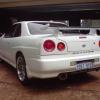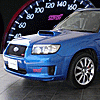Link G4 Plug-In Vs Vipec V44 Plug-In
Announcements
-
Similar Content
-
Latest Posts
-
If the RB29 box in the car is a push clutch, then yes, you will need to deal with the pull clutch on the turbo box. You either buy a pull clutch and don't use the old one, or you do the things needed to convert the turbo box's clutch arrangement over to push. Which is a bit of a f**karound. "Making" a custom tailshaft is the easy part. But you will need to source the front clip yoke - the bit that goes into the output of the gearbox. These are not as easy to find. They are out there, but they don't grow on trees the way that they used to.
-
Indicator bulbs are way too bright to use as a "corner marker" (we call them parking lights too). Sure. Go ahead and do it. But realise that you wil need to come up with all your own wiring to do it, as no-one will have a standard howto worked out for Skylines. It's just a matter of abandoning everything that Nissan have done and starting from scratch. You'd probably be better off retrofitting tailght/brakelight globe bases into the front indicator housings and using the taillight circuit for your corner marker and the brake light as the indicator. You'd need to work out how to kill the marker circuit while the indicator is flashing, otherwise it won't flash on-off, just bright-less bright.
-
Hi. A little bit of an update. It maybe(hope not) looks like i would need a new tranny(it would be "maybe" a cheaper or better option anyway) So i need some info. I know i need a different propshaft(i can make custom one) LSD is not a problem cuz the engine will be still(for now) N/A RB20. So if i buy RB25DET NEO tranny...is there something else i need? I read something about push/pull type but i do not know if i need to "change" something or i can just plug n play onto my engine a go? Thanks for the advice
-
By OakvilleGTR · Posted
Good morning all, Bit of a random question but figured I’d finally throw it out after wondering for a long while. Before I start, I'm hoping to do this purely out of personal preference. I think it would look better at night, and don't mind at all spending a few hours and dollars to get it done. I've copied this from a non-Skyline specific forum, so I apologize for the explanation of our headlight switch setup that we all know. Here we go: Zero lights (switch off) Parking lights (switch position 1) being a rectangular marker on the outside of the housing, my low beam being the projector in the centre (position 2), and a high beam triggered by my turn signal stalk. Most North American cars I’ve owned of this era have power to the amber corner (turning indicator) light as part of the first switch (parking lights). I’d love to have these amber corners receive power when the headlights and parking lights are on (headlight switch), yet still blink when using the turn signal which is of course a separate switch. Hopefully I’ve explained my question correctly. Is anyone aware of a way in which I might be able to achieve this? Thanks in advance -
My heads are cathedral port! It's likely possible, but I don't want to add any extra moving parts (I know they don't move) between the heads, manifolds, etc. It will also affect how injectors/fuel rails etc sit and I don't really know if it would change how the FAST manifold goes/sits/fits. I have the LS6 steam pipes already as I have a very late LS1 block so it should be fine. I couldn't find anyone who had ever actually used one for this purpose, it seems 100% of people grind the water pump. The thermal spacers are 12mm and are half way to the cost of the newer water pump anyhow... so if it comes to that I suppose I'd rather buy a new pump. The bearing in the pump I do have is a little.. clunky, but it hasn't done that much time and I never noticed it when the car was together in the past few years, so..
-






Recommended Posts
Create an account or sign in to comment
You need to be a member in order to leave a comment
Create an account
Sign up for a new account in our community. It's easy!
Register a new accountSign in
Already have an account? Sign in here.
Sign In Now